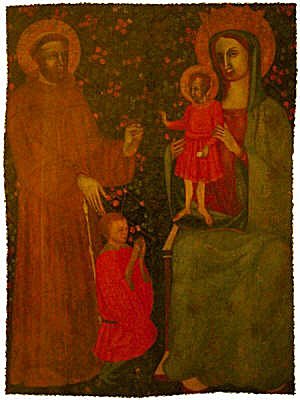Milicia
Milicia, before renovation
Madonna della Milicia
Madonna of Loreto
in Altavilla Milicia, about 20 km East of Palermo, in church Madonna della Milicia, second half of 14th century, 76.5 x 101.5 cm.
Pictured are two versions of the same icon: firstly the original state it was restored to in 1990, when the silver template and several layers of re-painting were removed, then the way it was presented since 1853, when popular devotion wanted the Madonna and child, as well as parts of Saint Francis of Assisi covered in silver plating and studded with precious stones. The practical reason behind this may have been to protect the icon from the touches and kisses of pilgrims. However, the occasion seems to have been seen as an opportunity to augment the glory of the sacred image and to give the silversmith free artistic range. So he undressed Jesus and made him sit like a baby rather than stand like a toddler. He made Mary stand up from her throne, but gave her a more royal outfit in compensation. He tied Saint Francis’ belt further up, making it look like a cane. Then he disappeared the figure of a kneeling young man whom Saint Francis recommends to the Virgin. Most likely this is the person who commissioned the work, possibly a certain Marquis Francisco Maria Beccardelli of Bologna, who probably wanted this painting for his personal chapel in his palace and ordered it from a Tuscan artist.
After renovation
I agree that the Marquis distracts from the spiritul power of the painting and it seems a bit presumptuous for the painter to dress him in the colors of Jesus and Mary. However, it seems equally as presumptuous to change the character of the image that dramatically and to alter every part of it.
This Mother of God is also called the Madonna of Loreto. I suppose she is meant to be a copy or variation of that other, much more famous Black Madonna. As in Loreto, baby Jesus stands upright on his Mother’s knee with a similar fold of her mantel under him and his hand raised in blessing. The silver mantel also shows a certain similarity to the Loreto brocade mantel.
Like any real Black Madonna, the Madonna della Milicia is considered a miraculous image and, it seems, as such she needed a good legend of origination. Here is the story people tell:
The template that covered the painting for 137 years.
She was a gift (from God) to the people of Milicia, coming to them from a Corsican pirate ship. The vessel was miraculously prevented from continuing its route on the sea off the coast of Milicia. The sacred icon didn’t allow the ship to proceed because the disrespectful crew had used it as a cover for a barrel. Only once Our Lady was passed into good and devout hands, could the ship be moved again. In a spiritual rescue mission of sorts, her devotees carried this treasure to land and placed it in an ox cart. Without any interference from the people, the oxen took the sacred image to the chapel where it wanted to be venerated. Gradually the original building became the present sanctuary.
This theme of God preventing a ship from continuing its course until its Madonna is given up to the local population recurs with suspicious frequency around the Italian coastline. I wouldn’t doubt that people actually used some less than friendly means to enforce what they wanted to be God’s will. All over Europe medieval Christians stole religious treasures from eachother and enshrined them in splendid cathedrals.
This Black Madonna’s yearly festival is held on September 6-8th, the birthday of the Virgin Mary. It is one of the most fervent Marian festivals of Western Sicily. It starts as the faithful begin their pilgrimage to the sanctuary of the Madonna often on foot, reciting the rosary, and illuminating their way with votive candles and torches. It culminates in a great procession when the Black Madonna is placed on a giant float, 12 meters high, that represents the ship she came in on and is drawn by two teams of oxen in commemoration of the oxen who took her to her final destination.¹ At one point two girls dressed as angels, are lowered from above onto the float as they sing the praises of the Madonna in their Sicilian dialect.²
Footnotes:
1. For more information on the connection between Black Madonnas and Sacred Bulls, Oxen, and Cows see: Olot.htm
2. All info taken from the following websites: www.isolafesta.it/smariadellamilicia and www.madonnamilicia.it






